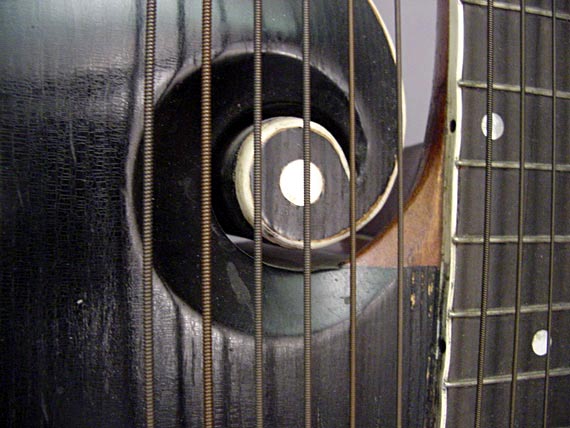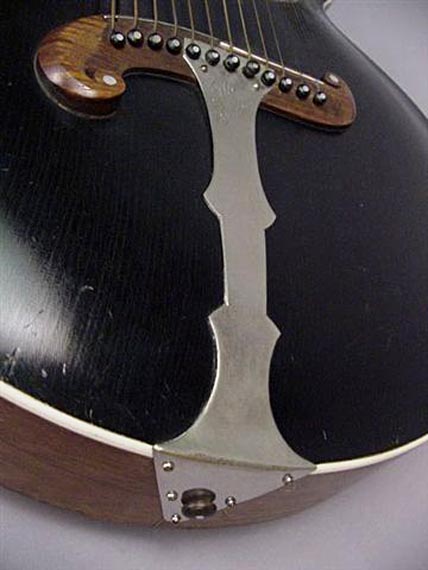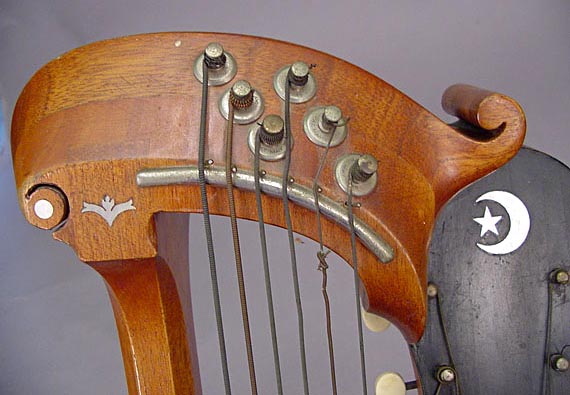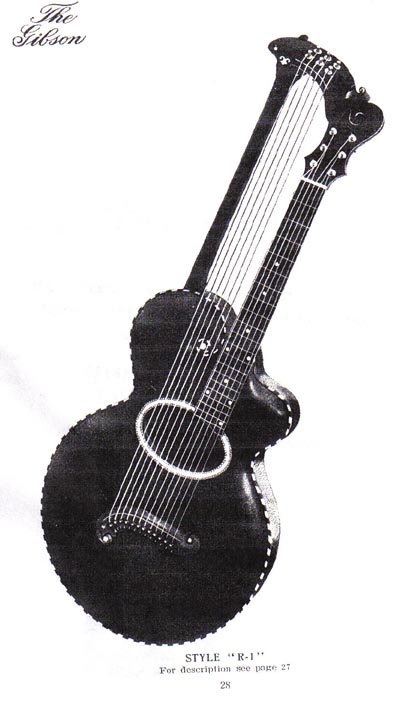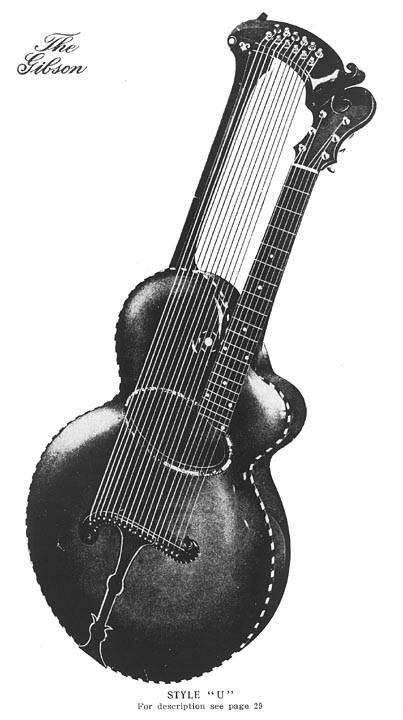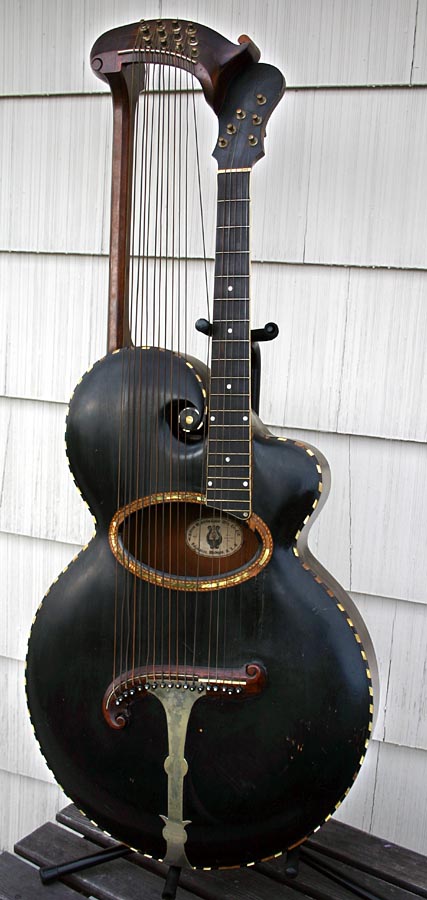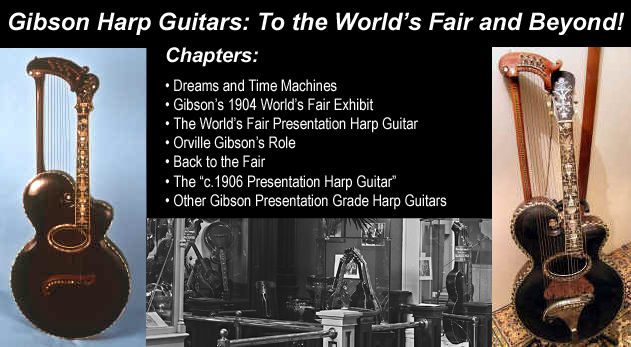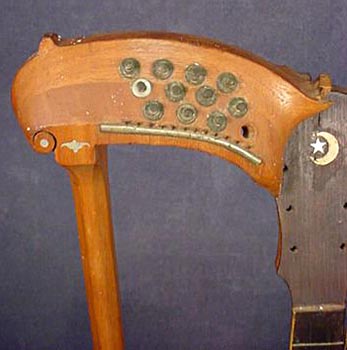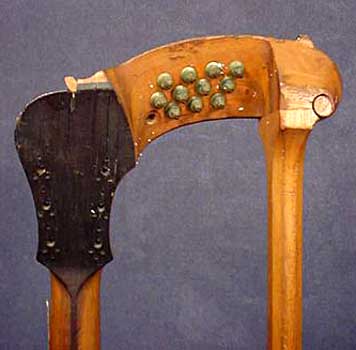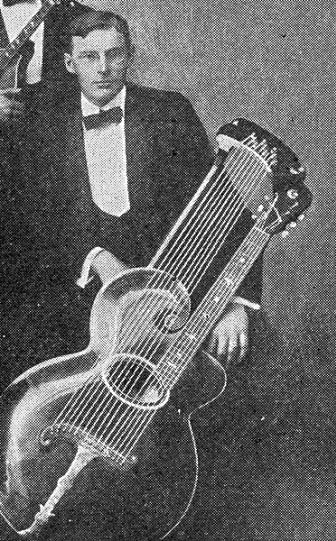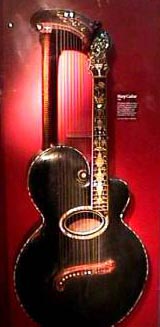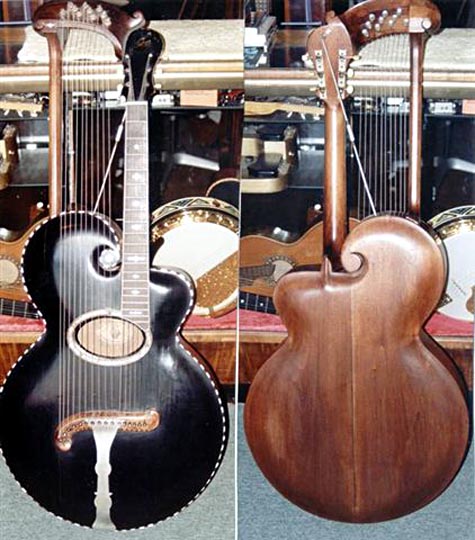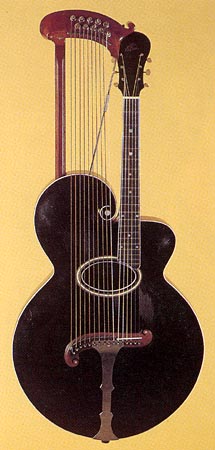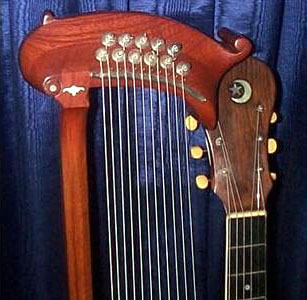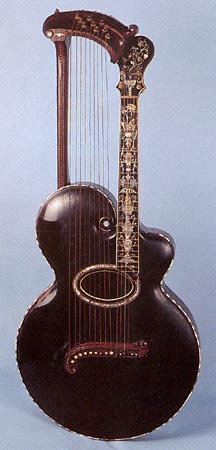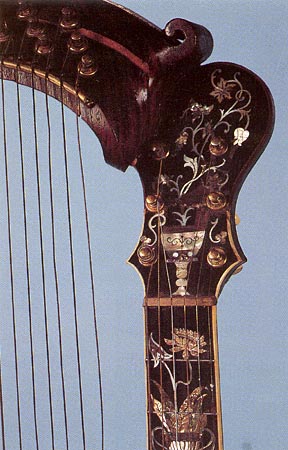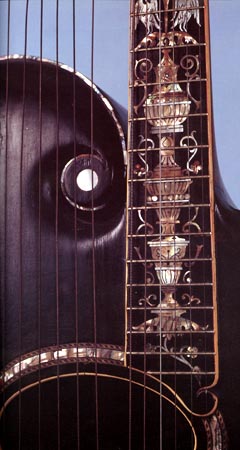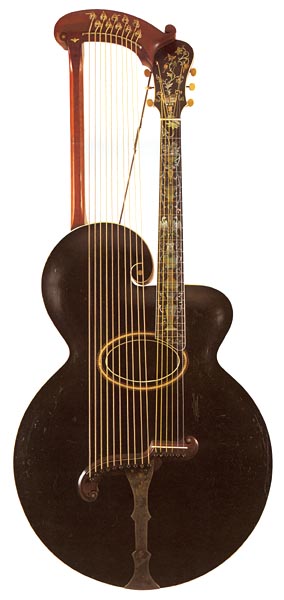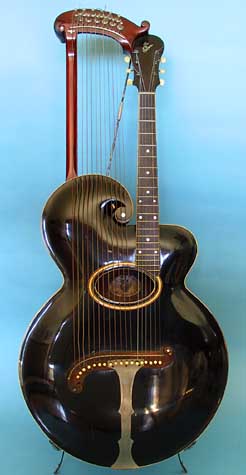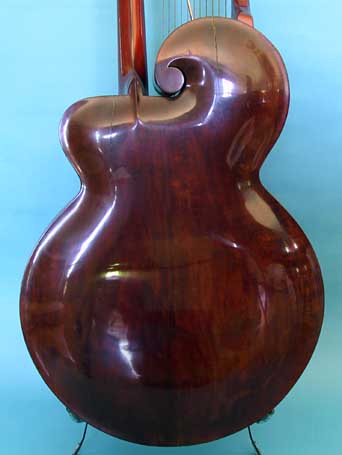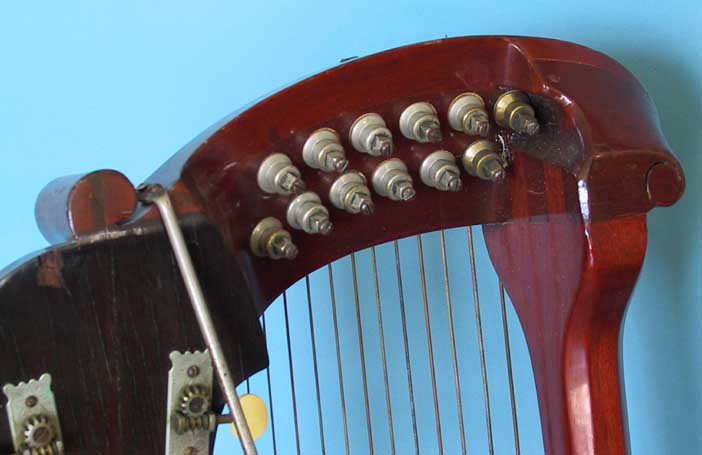|
Chapter 2. The First Years of Production: Style U, U1, R and R1 In
1903 Gibson's harp
guitars were expensive and their only guitar to come in
four different models.  On
this Gibson workers factory photo you can see a harp guitar frame. The massive
neck block and the 3 tail blocks are clearly visible. The
style R: This
was the plainest harp guitar of the 1903 catalogue listed at
$195.03. 6 regular strings and 6 bass strings tuned F, G,
A, B, C, D (low to high). This design didn’t last
very long and several changes were made: The banjo-like tuners for the guitar
strings were replaced by three-on-a-plate open back tuners with ivoroid knobs.
The ebonized finish becomes standard on the top. The fret markers were changed
to simple dots for the 5th, 7th, 9th and 15th position and double dots for the
12th and 17th position. Original model but with geared tuners and solid,
non-scroll headstock.
Style
R from 1907. On these photos the black finish to is the ebonized finish of the
time. Note the one-piece walnut back.
On
this photo you can see the classic Gibson early neck junction, round, and
the lack of binding on this part of the instrument.
The
bridge is glued like in the STYLE O guitar from the early 1900’s but has a
most peculiar metal reinforcement plate, engraved with “THE GIBSON,” to
prevent the bridge from pulling out.
In
this image you can see the head construction with cross grain mahogany wood to
reinforce the guitar. The sub-bass pegs are visible. The
R1 The
R1 is a fancier version of the
R with more decorations, listed at $221.63. The top comes with an ebonized finish
highly French polished. Ornamented and veneered headpiece. The bridge is
hand-carved and ornamented. Bindings on top have a cord pattern of pearl and
ebony. The oval soundhole is inlaid with fancy-colored woods and
mother-of-pearl. After a few years some
changes came to the R1; the cord pattern binding was dropped, and like the style
R, geared tuners were used on the guitars strings. Actually, it is difficult to
determine whether the R1 and R models didn’t became one after a while.
Photo
from the 1903 catalogue At $265.96, this harp guitar
which Gibson called the "18-string harp guitar"
is a
true monster with a total length of 48 inches, 21 inches width, guitar scale of
27 ¼ inches like a modern baritone guitar, and a maximum length of 35 ½ inches
for the sub-bass strings. The rest of the guitar is very close to the STYLE R1
apart from a strange adjustable extension steel rubber-capped rod, eighteen
inches long, enabling the performer to hold the instrument in an upright
position (states the catalogue). The twelve sub-bass strings are tuned
chromatically starting with the E flat just below the guitar Low E.
The model
was basically an 18 string giant.
Photo from the 1903 catalogue
This
is the only known image of an actual Style U specimen from the 1903 catalog! Rope binding, scroll
on the headstock with no "The Gibson" logo, 6X2 bass
tuners and banjo tuners for the guitar strings. Until I saw this, I wasn't even sure that they ever actually made the 'catalog model.' I
wonder if this one had the stand spike? Orville-built (and/or supervised) harp guitar serial #2502. This is the earliest known serialized Gibson Company instrument, discovered in 2007. See Harp Guitar of the Month for a full study. More early Gibsons with possible Orville construction or involvement include some of those in Gregg's 2016 article: This photo shows
a slightly later Style U with the original 12 basses. You can clearly see the difference with
the tuners in the catalog: They are in three rows instead of two. This instrument
already has guitar tuners and normal ivoroïd binding.
On this very bad condition style
U you can clearly see the 12 bass tuners in this
same original position. Like
the other models, the U suffered several changes; the 12 sub bass strings were
tuned too low and the model was changed to less basses. It’s difficult to 9 sub-bass transitional model In between the 12 sub-bass model, tuned E’ to D#, and the 10 sub-bass models, tuned A#’ to G#, GIBSON did a batch of 9 sub-bass Style U harp guitars. One might suspect that they were made to match the tuning of the German kontragitarres. The failure of the Style U may have been that people were complaining about the lack of sound of the lowest basses. So Gibson apparently then just removed the low 3 basses E’, F’ and F#’. The 9 sub-bass version was in all ways similar to the 12 sub-bass models, but instead of three rows of 4 tuners they just have three rows of 3 tuners on the sub-bass head.
Gibson
player with a 9 sub-basses model You
can see in this photo a Style U with moon and crescent inlay, no tension
rod and original 9 sub-bass strings. Style U1 with 9 basses This is a top of the line Style U1 with 9 sub-basses. Note again that there is no tension rod!
This
Style U, owned by Steve Bissell, originally had 9 sub-basses. A 10th
sub-bass has been added on the left. Note that the tension rod is in the
wrong position – a later addition with the 10th bass? So
what do we know now? Gibson did some 9 basses, while at the same time the
catalogs speak of the possibility of using gut strings on their harp
guitars. Was it a way to gain the favour of kontragitarre players? German
and Austrian immigrants were numerous in the U.S. back in the early 1900s,
so it’s interesting to think about. The more regular 10 contra bass strings (tuned from high to low: G#, G, F#, F, D#, D, C#, C, B, A# - with the G# unison with the 4th fret of the low E string of the guitar neck) was apparently quickly adopted. The tuning was recommended in Gibson literature of the era. Another change was the use of a reinforcement steel rod on the back of the instrument from the guitar head to the body. Again, like the R1, dots were installed on the fingerboard and the binding was changed to a simple ivoroid. Another change is the left spike on the headstock which started to disappear on the latest models. A 10 sub-bass U Here we have a peculiar 11 basses U with original star and crescent logo. The
U1 Again, just a more fancy
version of the U - $354.60, which was quite a lot of money for the time. The headpiece
bound in celluloid is ornamented in rich The same changes where
done on the U1 as the U and R. 9-string instruments are known to exist.
A
very rare 9-bass Style U1 almost fully original with the transitional 9
basses, rope binding; missing the bridge plate and reinforcement bar. Note delicate
head inlay and fingerboard end, disposition of the bass tuners and original
banjo tuners. |



